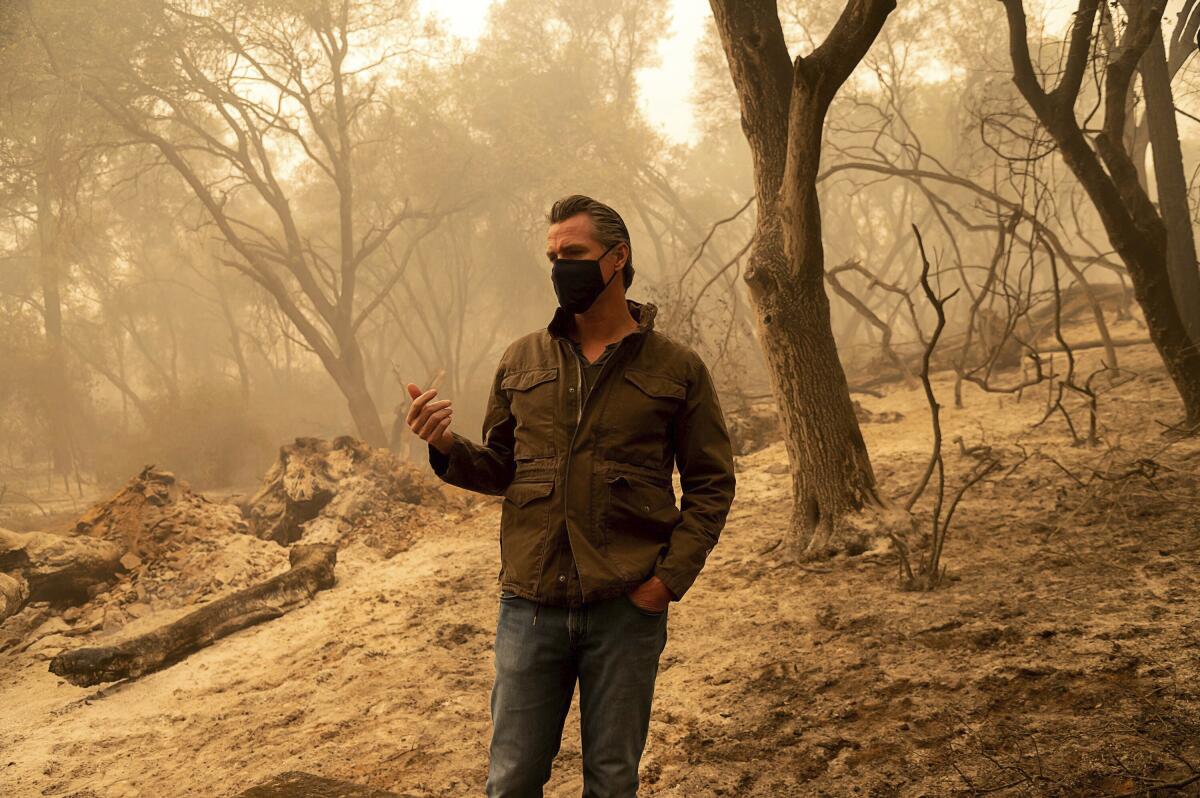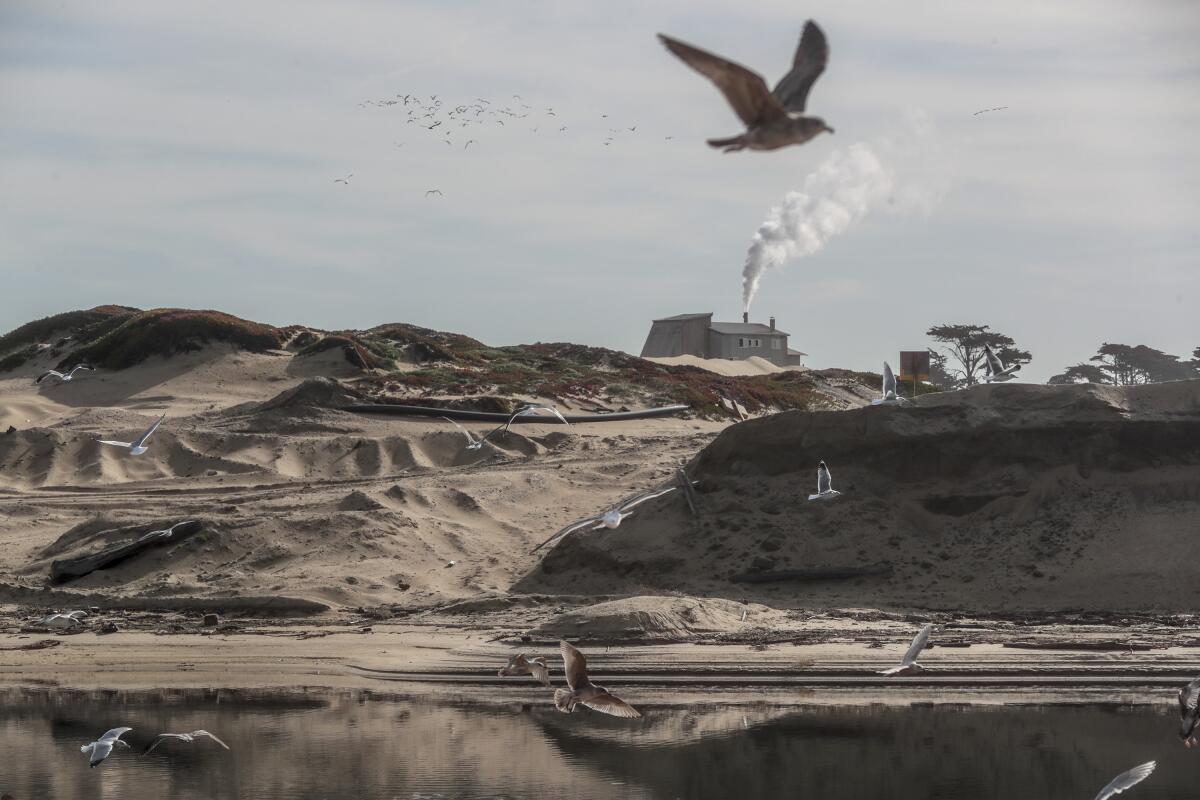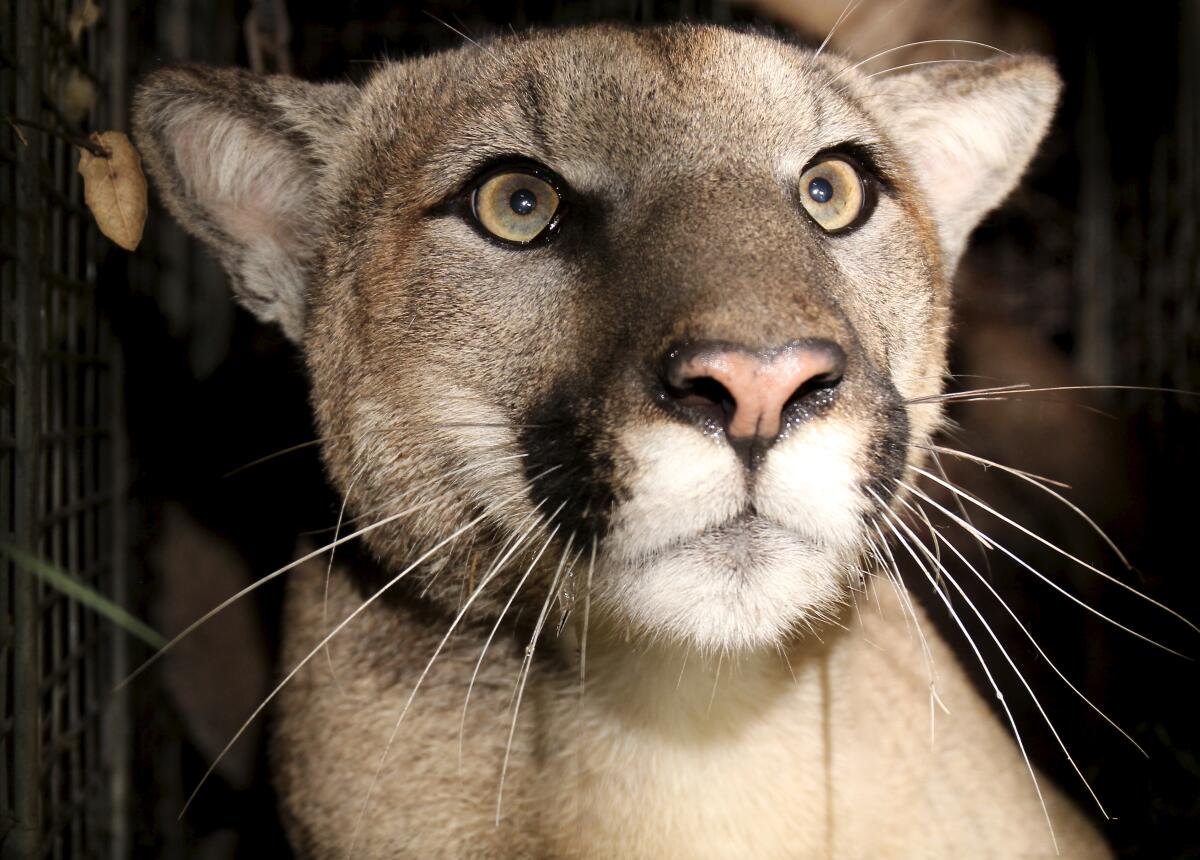Boiling Point newsletter: Gavin Newsom just promised ‘giant leaps forward’ on climate. Will he follow through?
- Share via
You probably weren’t surprised to read that President Trump, visiting California amid historic fires, denied the scientific reality of climate change, making the ludicrous claim: “It will start getting cooler, you just watch.”
You probably were equally unsurprised to read that Gov. Gavin Newsom acknowledged the scientific reality, calling the wildfire calamity a “climate damn emergency.”
The thing is, we’ve reached a point in human history where talk is cheap. The Northern Hemisphere just concluded its hottest summer on record; Antarctic glaciers are tearing away from their restraints; more than 3.2 million acres have burned this year in California, a runaway record. Acknowledging the existence of the climate crisis doesn’t do much for me these days.
What really caught my attention was the governor’s pledge to do more.
Toward a more sustainable California
Get Boiling Point, our newsletter exploring climate change, energy and the environment, and become part of the conversation — and the solution.
You may occasionally receive promotional content from the Los Angeles Times.
Newsom said he had directed two of his top environmental officials, Jared Blumenfeld and Wade Crowfoot, to review the state’s current climate strategies “and accelerate all of them, across the board.”
“While we’re leading the nation in low-carbon green growth, as we’ve led the nation in our efforts to decarbonize our economy, we’re going to have to do more, and we’re going to have to fast-track our efforts,” Newsom told reporters as he stood among charred trees in Oroville. “While it’s nice to have goals to get to 100% clean energy by 2045, that’s inadequate.
“Across the entire spectrum, our goals are inadequate to the reality we’re experiencing,” he added.

I found the governor’s comments especially striking because of all the heat he’s taken from climate activists over the last six months. As the COVID-19 pandemic has raged, critics say, Newsom has squandered an opportunity to move faster on reducing planet-warming emissions, and at times has slowed or backtracked on climate action.
Why are climate activists so frustrated with Newsom? Here are a few reasons:
- The Public Utilities Commission, whose members are appointed by the governor, voted in March to set a 2030 climate target that could actually slow the rate of emissions reductions from power plants.
- The Department of Conservation issued many more oil and gas drilling permits during the first half of 2020 than it did during the first half of 2019, including four dozen permits for the drilling technique known as fracking.
- Newsom asked the state’s oil regulator to determine whether buffer zones are needed around oil and gas wells to protect the health and safety of nearby residents, but hasn’t taken a strong stance on what action, if any, should be taken.
- During the power supply shortages that led to brief rolling blackouts last month, Newsom issued emergency proclamations that allowed power plants and portable generators to produce more air pollution than would normally be allowed.
- The State Water Resources Control Board, whose members are appointed by the governor, voted this month to allow four fossil fueled power plants along the Southern California coast to keep operating past the end of this year.
The California League of Conservation Voters issued a written statement last week slamming Newsom and state lawmakers.
“The Legislature ended yet another year of policymaking without passing bold laws to prepare for and prevent what’s happening,” said Mary Creasman, the environmental group’s CEO. “The governor has amped up fossil fuel usage through executive orders the past month, which we already know exacerbates our climate crisis.”
“We’re in the dark about how the governor is prioritizing climate change solutions, and we can’t wait any longer,” she added.
A group called Elected Officials to Protect California — which has garnered support from more than 300 local politicians — was even more critical, accusing Newsom last week of “shadow dancing” on climate change. The group wants the governor to require 2,500-foot buffer zones around all oil and gas wells, and to accelerate the transition to 100% clean energy.
Speaking of clean energy, critics say Newsom has done little to stem the tide of job losses caused by the COVID-19 pandemic. More than 84,000 clean energy workers have lost their jobs in California alone, even after some recent gains, according to unemployment data analyzed by BW Research. Nationally, the clean energy sector has lost nearly 500,000 jobs in six months.
I wrote in July about renewable power companies and climate activists urging Newsom to act quickly to bring some of those jobs back. So far, they say, the governor hasn’t taken any of the steps they recommended.
“The governor’s got to take responsibility here and apply some of the same creative thinking that he’s applied to the virus,” veteran clean energy lobbyist V. John White told me this week.
After I wrote about the lack of action on clean energy jobs, I got a chance to talk with Jared Blumenfeld, who leads the California Environmental Protection Agency. Blumenfeld described several ideas that were being discussed by the governor’s task force on jobs recovery, including financing mechanisms to promote electric cars, a “climate justice corps” jobs program to put Californians back to work on conservation projects, and strategies to promote working from home even after the pandemic ends.
Have the task force or state agencies followed through on any of those ideas, or developed any formal proposals? And more broadly, what specifically are Newsom and his lieutenants planning to do to pick up the pace on climate action?
I posed those questions to Newsom’s office, CalEPA and the Natural Resources Agency.
Newsom’s press secretary, Jesse Melgar, told me via email that officials are “hard at work implementing the state’s ambitious climate policy portfolio,” and that additional efforts “are being explored and more action to address the effects of climate change will be announced in the coming weeks.” Similarly, spokespeople for the agencies told me they don’t have any specifics yet.
CalEPA spokeswoman Erin Curtis did list several actions state officials have taken on climate in recent months. The Air Resources Board mandated a big increase in zero-emission trucks and required docked ships to reduce air pollution. Atty. Gen. Xavier Becerra filed more lawsuits against the Trump administration to block environmental rollbacks. The state kept funding climate projects such as fire prevention. And Newsom struck a deal with 14 other states to collaborate on electric vehicle chargers.
Newsom, meanwhile, is defending the state water board’s decision to extend the shutdown deadline for four gas-fired power plants that were supposed to close this year. The plants are still needed to keep the lights on, he told reporters last week.
“It was absolutely not a mistake. It was the right thing,” he said. “We’re going to make giant leaps forward to make that negligible in the context of our total overall strategies.”
“Giant leaps forward.” It’s a bold promise, and one that I intend to keep in the spotlight. If Newsom and his appointees follow through, you’ll read about it here; if not, you’ll read about that here too.
For now, here’s what else is happening around the West:
CLIMATE APOCALYPSE
Climate change is fueling record fires, heat and smog. If you read anything about global warming’s role in the ongoing calamities, read this story by my colleagues Susanne Rust and Tony Barboza, which offers a painful reminder of how long we’ve known this was coming. Ron Lin and Joseph Serna went into more detail on the role of rare summer snow in Colorado in stoking the flames. And Bettina Boxall explained how a century of poor forest management and years of drought “set the stage for forest conflagrations akin to World War II fire bombings” in the Sierra Nevada, with climate change as the “frosting on the cake.”
How unprecedented are these fires? Our data department produced some stunning visualizations showing, among other things, that the equivalent of five downtown L.A.’s worth of buildings have been destroyed statewide. The Mt. Wilson Observatory could soon join the list; the Bobcat fire, which has evaded firefighters and forced evacuations in the San Gabriel Valley, is nearing the historic observatory where Edwin Hubble confirmed the existence of other galaxies. Conditions are equally bad in the Pacific Northwest, where The Times’ Richard Read reports that climate change is almost certainly stoking rare Santa Ana-like winds.
For those of us not in the line of fire, smoke is the worst part. Even before the fires got bad, record heat led to L.A. suffering its worst smog in 26 years, Tony Barboza reports. (California was one of six Western states to experience its hottest August on record.) Add in wildfire smoke, and four of the world’s 10 most polluted cities this weekend were Portland, Seattle, San Francisco and L.A. There was so much smoke that it partially shrouded the sun on the East Coast and even reached Europe. There was so much smoke that The Times’ Paul Duginski invoked Edvard Munch’s “The Scream” to explain the sky-turning-red phenomenon.
If you want to support our climate journalism, please consider subscribing to the Los Angeles Times. It’s not expensive and it makes this work possible. Take a look at subscription options here.
HEARTBREAK AND HOPE
I couldn’t possibly share every story of heartbreak we’ve published this week; there are too many. But here are a few: the logger-turned-conservationist who has gone missing in the burning forest he helped save; the town that may suffer the same grim fate as nearby Paradise; the immigrant-owned market, now destroyed, at the heart of that town; the son who didn’t know if his mother lived or died; the teenage boy who lost his life; the failure of public warning systems; and the devastation of towns with names designed to make you smile, like Happy Camp, and towns with names that couldn’t feel more poignant, like Phoenix.
If you’re feeling down, you’re not alone. My colleague Julia Wick wrote about climate change’s psychological toll, introducing me to the term “solastalgia,” which combines the words nostalgia, solace and desolation to describe a “profound sense of loss and isolation, and the overwhelming feelings of powerlessness” that come with it. Times columnist Steve Lopez, too, lamented that the California he grew up in is no longer the state he knows today. And Maria La Ganga reflected on the return of the hazy, sickening air she associates with the Southern California of her childhood, calling it “a dire reminder of the bad old days.”
We’re also got some “news you can use,” of the unfortunate variety. Ada Tseng explained how to read and understand air quality numbers and maps, which many of us are likely dealing with for the first time. Ada, Jessica Roy and Matt Ballinger are also answering your questions about air quality and how to stay safe. And in our daily coronavirus newsletter, Soumya Karlamangla addressed the extremely depressing question of how to differentiate between symptoms of smoke inhalation and COVID-19.
But there’s always hope; like Mr. Rogers said, during times of disaster, look for the helpers. Like the woman who couldn’t afford her phone bill but still helped neighbors prepare to evacuate, or the volunteers driving into fire zones to rescue stranded animals. And don’t forget that Californians are, in fact, tough as nails, contrary to how we’re often stereotyped; between fires and earthquakes and heat waves and mudslides, we’ve learned to be resilient, Times columnist Mary McNamara writes. It’s especially true in Butte County, where columnist Erika Smith reports that years of fires have failed to break the community’s spirit.
Enjoying this newsletter? Consider subscribing to The Times
Your support helps us deliver the news that matters most, and makes newsletters like Boiling Point possible. Become a Los Angeles Times subscriber.
WATER IN THE WEST

A proposed desalination plant along the California coast has become a test of the state’s commitment to environmental justice. The Coastal Commission is considering whether to approve a facility that would provide clean water to farmers and reduce pressure on the Carmel River, but would continue a legacy of industrialization in a low-income town where many speak little English and where residents wouldn’t even receive water from the facility on their shoreline, my colleague Rosanna Xia reports.
Speaking of industrial facilities on the California coast, Redondo Beach plans to sue state officials over their decision to extend the shutdown deadline for four gas-fired power plants. Here’s the story from David Rosenfeld at the Daily Breeze.
The Colorado River is still trending in the wrong direction. Conservation efforts across the Southwest have helped stave off disaster so far, but the U.S. Bureau of Reclamation now projects there’s a one-in-four chance of Lake Mead reaching severe shortage levels by 2025, as Tony Davis reports for the Arizona Daily Star. In related news, The Times’ Paul Duginski writes that La Niña conditions are back in the Pacific Ocean, which means “the dice are loaded for drought” in California. Just what we need!
VARIOUS OTHER THINGS
A chemical spill in the Compton area spurred hundreds of complaints of gas-like odors. Because wildfire smoke isn’t enough, right? Here’s the story from my colleague Tony Barboza, who notes that the chemical spilled, mercaptan, was also part of the Aliso Canyon gas leak. Also check out this essay by Adam Mahoney for High Country News on growing up in in Wilmington, known as Southern California’s “Cancer Alley” due to the area’s concentration of five oil refineries, three freeways and the port complex.
Tesla’s got another challenger, at least for people with $150,000 to spend on a car. Even if that doesn’t describe you, you still might want to pay attention to Lucid Motors, since the company’s cutting-edge technology “will trickle down to mass-market electric cars, which, by replacing internal combustion engines, will help fight global warming,” as The Times’ Russ Mitchell writes.

Biologists have discovered several L.A.-area mountain lions with physical deformities that are signs of inbreeding. It’s not a good sign for genetic diversity in the isolated cougar communities of the Santa Monica Mountains, Louis Sahagun writes.
And one last story of fire and rescue. This harrowing narrative by Thomas Curwen will keep you reading until the very end.
What do you want to know?
When you think about California’s climate future, what comes to mind? What keeps you up at night, and what gives you hope or gets you excited? What do you want to understand, and what should I?
This newsletter is for you, to help you understand how we’re changing our world and what we can do about it, and I want to hear your questions, concerns and ideas. Email me or find me on Twitter.
ONE MORE THING
A new study finding the Coachella Valley’s tourism season will get a lot shorter due to climate change didn’t exactly surprise me; I lived in Palm Springs for four years and even wrote about global warming and tourism. But I was startled by the comment that the Greater Coachella Valley Chamber of Commerce offered the Desert Sun’s Melissa Daniels and Mark Olalde:
“If the weather patterns change as dramatically as they suggest, tourism impact will likely be the least of society’s concerns.”
I mean ... yep.
I’ll be back in your inbox next week. If you enjoyed this newsletter, please consider forwarding it to your friends and colleagues.




